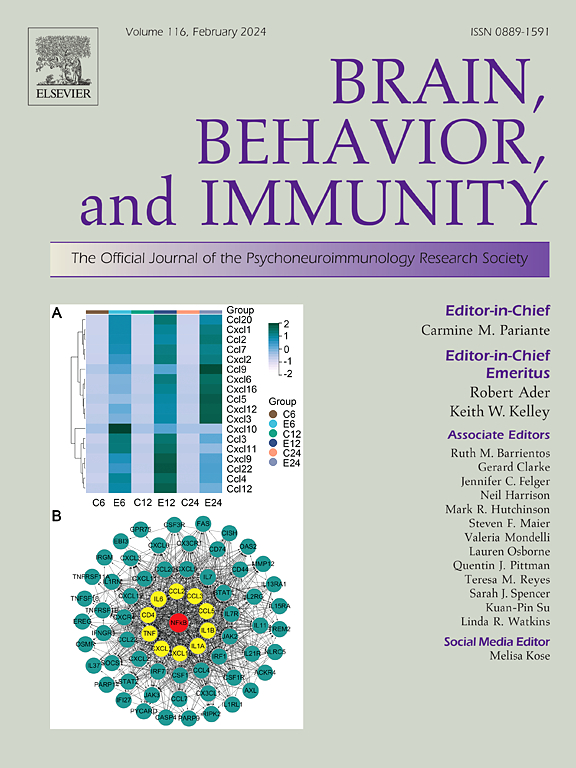Executive function and soluble urokinase-type plasminogen activator receptor (suPAR): a longitudinal study of midlife adults
IF 7.6
2区 医学
Q1 IMMUNOLOGY
引用次数: 0
Abstract
Executive function (EF) declines with age. Declines in EF are associated with adverse outcomes, but there is substantial inter-individual variability in rate and magnitude of decline. Evidence suggests that systemic inflammation may contribute to declines in EF. Extant studies are largely cross-sectional and examine markers of inflammation that are not specific to the immune system and influenced by acute contemporaneous factors. We examined a newer marker of chronic inflammation, soluble urokinase Plasminogen Activator Receptor (suPAR) alongside more traditional markers, IL-6 and CRP. We hypothesized that higher baseline and greater increases in suPAR across an 8–19 (median 17) year period of midlife would associate with larger age-related declines in EF. Data were drawn from the Adult Health and Behavior (AHAB) study (n=599). Participants (55.5% female, 86.2% white, mean age 45 years at W1 and 60 years at W2) completed a neuropsychological battery and blood draw at both waves. EF was comprised of the Trail Making Test, the STROOP Test, and Matrix Reasoning. Univariate and Bivariate Latent change score models (LCSM) examined whether baseline and change in circulating levels of inflammatory mediators were associated with change in EF from W1 to W2. Baseline inflammation was not associated with change in EF. Increases in suPAR were significantly related to concomitant declines in EF (= −0.315; p <.05). No similar effects were observed for IL6 or CRP. Further research should examine suPAR as potential marker of chronic systemic inflammation and its relationship to cognitive aging.
执行功能和可溶性尿激酶型纤溶酶原激活物受体(suPAR):一项中年成年人的纵向研究。
成年期认知能力下降与不良后果有关,如患痴呆症的风险增加。有证据表明,全身性炎症可能导致认知老化。现有的研究大多是横断面的,并检查炎症标志物,这些标志物不是免疫系统所特有的,而且受急性同期因素的影响。我们研究了一种新的慢性炎症标志物,可溶性尿激酶纤溶酶原激活物受体(suPAR),以及更传统的标志物,IL-6和CRP。我们假设,在8-19年(中位17年)的中年期间,较高的基线和较大的suPAR增加与执行功能(EF)的较大年龄相关下降有关。数据来自成人健康与行为(AHAB)研究(n=599)。参与者(女性55.5%,白人86.2%,T1时平均年龄45岁,T2时平均年龄60岁)完成了神经心理测试和两波抽血。EF测试包括造径测试、STROOP测试和矩阵推理。单变量和双变量潜在变化评分模型(LCSM)检验了炎症介质的基线和循环水平的变化是否与从T1到T2的EF变化相关。基线炎症与EF的变化无关。suPAR的变化与伴随的EF变化显著相关(= -0.315;p
本文章由计算机程序翻译,如有差异,请以英文原文为准。
求助全文
约1分钟内获得全文
求助全文
来源期刊
CiteScore
29.60
自引率
2.00%
发文量
290
审稿时长
28 days
期刊介绍:
Established in 1987, Brain, Behavior, and Immunity proudly serves as the official journal of the Psychoneuroimmunology Research Society (PNIRS). This pioneering journal is dedicated to publishing peer-reviewed basic, experimental, and clinical studies that explore the intricate interactions among behavioral, neural, endocrine, and immune systems in both humans and animals.
As an international and interdisciplinary platform, Brain, Behavior, and Immunity focuses on original research spanning neuroscience, immunology, integrative physiology, behavioral biology, psychiatry, psychology, and clinical medicine. The journal is inclusive of research conducted at various levels, including molecular, cellular, social, and whole organism perspectives. With a commitment to efficiency, the journal facilitates online submission and review, ensuring timely publication of experimental results. Manuscripts typically undergo peer review and are returned to authors within 30 days of submission. It's worth noting that Brain, Behavior, and Immunity, published eight times a year, does not impose submission fees or page charges, fostering an open and accessible platform for scientific discourse.

 求助内容:
求助内容: 应助结果提醒方式:
应助结果提醒方式:


